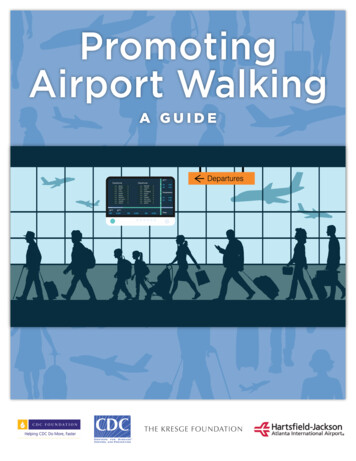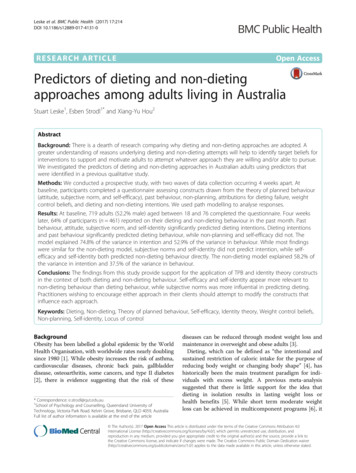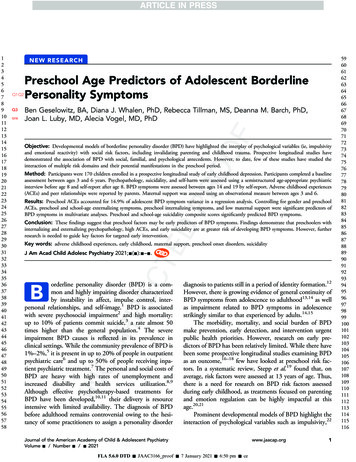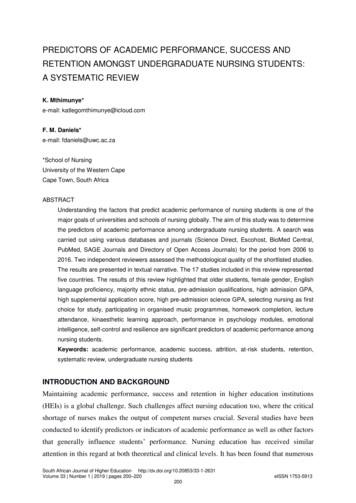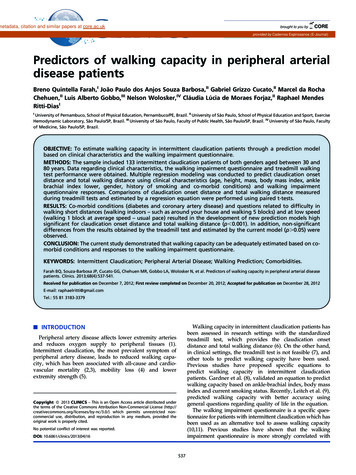
Transcription
metadata, citation and similar papers at core.ac.ukbrought to you byCORECLINICALSCIENCEprovided by Cadernos Espinosanos (E-Journal)Predictors of walking capacity in peripheral arterialdisease patientsBreno Quintella Farah,I João Paulo dos Anjos Souza Barbosa,II Gabriel Grizzo Cucato,II Marcel da RochaChehuen,II Luis Alberto Gobbo,III Nelson Wolosker,IV Cláudia Lúcia de Moraes Forjaz,II Raphael MendesRitti-DiasIIUniversity of Pernambuco, School of Physical Education, Pernambuco/PE, Brazil. II University of São Paulo, School of Physical Education and Sport, ExerciseHemodynamic Laboratory, São Paulo/SP, Brazil. III University of São Paulo, Faculty of Public Health, São Paulo/SP, Brazil. IV University of São Paulo, Facultyof Medicine, São Paulo/SP, Brazil.OBJECTIVE: To estimate walking capacity in intermittent claudication patients through a prediction modelbased on clinical characteristics and the walking impairment questionnaire.METHODS: The sample included 133 intermittent claudication patients of both genders aged between 30 and80 years. Data regarding clinical characteristics, the walking impairment questionnaire and treadmill walkingtest performance were obtained. Multiple regression modeling was conducted to predict claudication onsetdistance and total walking distance using clinical characteristics (age, height, mass, body mass index, anklebrachial index lower, gender, history of smoking and co-morbid conditions) and walking impairmentquestionnaire responses. Comparisons of claudication onset distance and total walking distance measuredduring treadmill tests and estimated by a regression equation were performed using paired t-tests.RESULTS: Co-morbid conditions (diabetes and coronary artery disease) and questions related to difficulty inwalking short distances (walking indoors – such as around your house and walking 5 blocks) and at low speed(walking 1 block at average speed – usual pace) resulted in the development of new prediction models highsignificant for claudication onset distance and total walking distance (p,0.001). In addition, non-significantdifferences from the results obtained by the treadmill test and estimated by the current model (p.0.05) wereobserved.CONCLUSION: The current study demonstrated that walking capacity can be adequately estimated based on comorbid conditions and responses to the walking impairment questionnaire.KEYWORDS: Intermittent Claudication; Peripheral Arterial Disease; Walking Prediction; Comorbidities.Farah BQ, Souza-Barbosa JP, Cucato GG, Chehuen MR, Gobbo LA, Wolosker N, et al. Predictors of walking capacity in peripheral arterial diseasepatients. Clinics. 2013;68(4):537-541.Received for publication on December 7, 2012; First review completed on December 20, 2012; Accepted for publication on December 28, 2012E-mail: raphaelritti@gmail.comTel.: 55 81 3183-3379Walking capacity in intermittent claudication patients hasbeen assessed in research settings with the standardizedtreadmill test, which provides the claudication onsetdistance and total walking distance (6). On the other hand,in clinical settings, the treadmill test is not feasible (7), andother tools to predict walking capacity have been used.Previous studies have proposed specific equations topredict walking capacity in intermittent claudicationpatients. Gardner et al. (8), validated an equation to predictwalking capacity based on ankle-brachial index, body massindex and current smoking status. Recently, Leitch et al. (9),predicted walking capacity with better accuracy usinggeneral questions regarding quality of life in the equation.The walking impairment questionnaire is a specific questionnaire for patients with intermittent claudication which hasbeen used as an alternative tool to assess walking capacity(10,11). Previous studies have shown that the walkingimpairment questionnaire is more strongly correlated with& INTRODUCTIONPeripheral artery disease affects lower extremity arteriesand reduces oxygen supply to peripheral tissues (1).Intermittent claudication, the most prevalent symptom ofperipheral artery disease, leads to reduced walking capacity, which has been associated with all-cause and cardiovascular mortality (2,3), mobility loss (4) and lowerextremity strength (5).Copyright ß 2013 CLINICS – This is an Open Access article distributed underthe terms of the Creative Commons Attribution Non-Commercial License (http://creativecommons.org/licenses/by-nc/3.0/) which permits unrestricted noncommercial use, distribution, and reproduction in any medium, provided theoriginal work is properly cited.No potential conflict of interest was reported.DOI: 10.6061/clinics/2013(04)16537
Predictors of walking capacity in PADFarah BQ et al.CLINICS 2013;68(4):537-541walking capacity than the quality of life questionnaire (12,13).However, whether the walking impairment questionnaireaccurately predicts claudication onset distance and totalwalking distance has not been not previously described.Our hypothesis is that clinical status and walkingimpairment questionnaire responses are significant predictors of walking capacity. Therefore, the aim of this studywas to estimate the walking capacity in intermittentclaudication patients through a prediction model based onclinical characteristics and the walking impairment questionnaire.speeds: slowly, average speed, quickly and jogging orrunning. Stair use ability is assessed by the difficulty ofclimbing up one, two or three flights of stair. We analyzedthe reliability of each question after seven days in asubsample of 25 patients, and the interclass correlationcoefficient ranged from 0.76 to 0.98.Statistical AnalysisData were analyzed using the Statistical Package for theSocial Sciences (SPSS version 10, SPSS Inc., Chicago, Illinois,USA). Normality was verified by the Kolgomorov-Sminorvtest. Multiple regression modeling was conducted to predictclaudication onset distance and total walking distance fromthe independent variables: age, height, mass, body massindex, the ankle-brachial index of the lower extremities,gender (male 1, female 0), smoking history (yes 1,no 0), co-morbid conditions (hypertension, diabetes, dyslipidemia and coronary artery disease; yes 1, no 0) andwalking impairment questionnaire responses (0 to 4).The claudication onset distance and total walkingdistance measured during the treadmill test were comparedto the estimated values of claudication onset distance andtotal walking distance obtained by the regression modelusing paired t-tests. The accuracy of the regression modelwas further examined by the absolute error [(absolutedifference between predicted and actual value)/actual valuex 100] and the proportion of predicted values within 10%,10-25% and .25% of the treadmill result (16). The significance level was set at p,0.05 for all analyses.& MATERIAL AND METHODSPatientsFour hundred forty consecutive patients were recruited ata tertiary care center that specializes in vascular disease.Patients with peripheral artery disease and claudicationsymptoms were included in this study if they had an anklebrachial index #0.90 at rest, no pain at rest, and no evidenceof mental disability identified by the Mini-Mental StateExamination Questionnaire (14) and were willing tovolunteer to participate in the study. A total of 133intermittent claudication patients were deemed eligible forthe study.AssessmentsDemographic information, height, weight, smoking history and comorbid conditions (hypertension, dyslipidemia,diabetes and coronary artery disease) were obtainedthrough medical history and physical examination. Ankleand arm blood pressures were assessed, and the anklebrachial index was calculated by the quotient of anklesystolic blood pressure over brachial systolic blood pressure(15).EthicsThe procedures used in this study were approved by theInstitutional Review Board of the University of Pernambucoand by the Institutional Review Board of the Hospital ofClinics of University of São Paulo. Written informed consentwas obtained from each patient prior to investigation.Walking capacity on treadmillThe patients performed a graded maximal treadmill test(model 2200.1 Trimline; Hebb Industries Inc., Whitehouse,Texas) using a specific protocol for patients with IC aspreviously described (6). Briefly, the treadmill speed wasmaintained at 2.0 mph, and the treadmill grade wasincreased 2% every 2 minutes until the patients could nolonger continue because of claudication symptoms. Theclaudication onset distance and the total walking distancewere defined, respectively, as the distance walked when thepatient first reported pain in the leg and the distance atwhich the patient was unable to continue to exercise due toleg pain.& RESULTSThe characteristics of the sample are shown in Table 1.Most of the patients were male (64.7%) and non-obese. Theprevalence of co-morbid conditions ranged from 38.6%(diabetes) to 76.7% (hypertension).Table 2 displays the responses for each question of thewalking impairment questionnaire: 27.9% of patientsreported being unable to walk 5 blocks, 85.7% reported thatthey are not able to jog or run, and 20.3% reported that theyare not able to climb three flights of stairs.Walking Impairment QuestionnaireTable 1 - General characteristics of intermittentclaudication patients (n 133).The walking impairment questionnaire is composed of 14items distributed in 4 domains, one including generalinformation and three regarding walking capacity (distance,speed and using stairs). Each item is ranked from 0 to 4 on aLikert scale, in which 0 represents unable to perform and 4represents no difficulty. These data were obtained throughpersonal interviews. The Brazilian Portuguese version of thewalking impairment questionnaire has previously beenvalidated (11).The distances that are assessed by the walking impairment questionnaire range from walking indoors around thehome to walking 5 blocks outside. The speeds are assessedas the difficulty of walking 1 block at each of the followingVariablesAge (years)Body mass index (kg.m-2)Ankle-brachial indexGender (% men)Smoking history (% yes)Hypertension (% yes)Dyslipidemia (% yes)Diabetes (% yes)Coronary artery disease (% 70.738.356.4Values are presented in mean ¡ standard-deviation or frequency.538
CLINICS 2013;68(4):537-541Predictors of walking capacity in PADFarah BQ et al.Table 2 - Frequency of responses on the Walking Impairment Questionnaire in intermittent claudication patients.Degree of DifficultyQuestionsDistanceQ1. Walk indoors (such as around your house)Q2. Walk 5 metersQ3. Walk 45 metersQ4. Walk 90 metersQ5. Walk 180 metersQ6. Walk 270 metersQ7. Walk 450 metersSpeedQ8. Walk 1 block slowly (slower than usual)Q9. Walk 1 block at average speed (usual pace)Q10. Walk 1 block quickly (faster than usual)Q11. Jog or run 1 blockStairsQ12. Walk up one flights of stairsQ13. Walk up two flights of stairsQ14. Walk up three flights of stairsNo (%)Slight (%)Some (%)Much (%)Unable 41.58.320.3Regression analyses indicated that Q1 (walking indoors –such as around your house), Q4 (walking 1 block) and Q9(walking 1 block at average speed – usual pace) of the walkingimpairment questionnaire, as well as diabetes and coronaryartery disease, were independent predictors of claudicationonset distance and total walking distance (Table 3). Predictionmodels resulted in moderate correlation coefficients (claudication onset distance: r 0.52; total walking distance: r 0.58) andnon-significant differences from the results obtained in treadmill test (Estimated by current model: claudication onsetdistance 2 175¡81 m and total walking distance 2408¡173 m; Measured by the treadmill test: claudication onsetdistance 2 175¡155 m and total walking distance 2408¡295 m; p.0.05). In addition, absolute errors less than25% were found for claudication onset distance (21%) and totalwalking distance (32%) (Figure 1).attributed to respiratory, metabolic and vascular dysfunction (21,22). In addition, diabetes has been associated withendothelial dysfunction and increased oxidative stress, proinflammatory status and mitochondrial dysfunction (23).Coronary artery disease patients also have endothelialdysfunction and experience reduced cardiorespiratory fitness compared to non-coronary artery disease patients (21).Although the walking impairment questionnaire has beenwidely used to assess walking impairment in intermittentclaudication patients (13,24,25), whether this questionnaireis able to predict walking capacity has not been previouslyanalyzed. The results of the present study indicate that thewalking impairment questionnaire predicts walking capacity in intermittent claudication patients. Questions relatedto difficulty in walking short distances and walking at lowspeeds were significantly correlated to claudication onsetdistance and total walking distance. Thus, it seems that thebest questions to predict walking capacity are thoseindicative of major limitations of the patient.Interestingly, in the present study, walking impairmentquestionnaire questions regarding climbing stairs were notpredictors of walking capacity in peripheral artery diseasepatients. Previous studies have observed that the climbing stairsdomain of the walking impairment questionnaire was correlated with walking capacity (11-13). However, these studieswere performed using bivariate analysis, which does notcontrol for the relationships between the climbing stairs domainand walking capacity to potential confounders, such as clinicalcharacteristics or other walking impairment questionnairedomains.Poor walking capacity has been associated with increasedrisk for all-cause and cardiovascular mortality (2,3), mobility& DISCUSSIONThe current study demonstrated that walking capacity maybe adequately estimated based on co-morbid conditions andwalking impairment questionnaire questions. Inclusion of comorbid conditions, such as diabetes and coronary arterydisease, as well as questions related to difficulty in walkingshort distances and at low speeds resulted in the developmentof new prediction models for walking capacity that are moreaccurate than previously published models for patients withintermittent claudication (8,9).In the present study, diabetes and coronary artery diseasewere independent predictors of walking capacity. Previousstudies have shown that diabetes and coronary arterydisease are related to walking impairment in intermittentclaudication patients (17-20), which has previously beenTable 3 - Prediction model for claudication distance and total walking distance in intermittent claudication patients.VariablesPrediction modelr (r2)SEECD (m)TWD (m) 221.535 (Q4625.351) (Q1631.484) (Q9627.146) - (diabetes presence x 47.909)a 109.251 (Q4678.825) (Q1669.756) - (diabetes presence x 116.255) - (coronary arterydisease presence x 98.725)b0.52 (0.27)0.58 (0.34)134242CD – claudication distance; TWD – total walking distance; a F4 16.66, p,0.001; b F4 12.07, p,0.001; r - multiple correlation coefficient, r2 - variance; SEE standard estimate of the error; Q – question of Walking Impairment Questionnaire.539
Predictors of walking capacity in PADFarah BQ et al.CLINICS 2013;68(4):537-541Figure 1 - Distribution of absolute error of the current prediction model for estimating claudication distance (Panel A) and totalwalking distance (Panel B).loss (4) and reduced strength in the lower extremities (5). Thus,the assessment of walking capacity is clinically relevant. Theresults of this study showed that walking capacity is adequatelyestimated based on clinical characteristics and walking impairment questionnaire questions; this is useful for clinicians toquantify the walking capacity of intermittent claudicationpatients easily.The present study has some limitations. Walking capacitywas assessed in the graded treadmill test. Therefore, otherways of assessing walking capacity (e.g., the 6-minute test)cannot be predicted using the regression models proposedin this study. The equations for predicting the claudicationonset distance and total walking distance were not crossvalidated in an independent group of similar peripheralarterial disease patients. This study included only peripheral artery disease patients with claudication symptoms,and the predictive models cannot be extrapolated forpatients with peripheral arterial disease in other stages.In conclusion, the model based on walking impairmentquestionnaire and co-morbid conditions adequately predictedthe walking capacity in intermittent claudication patients.This information is useful for clinicians to easily quantify thewalking capacity of intermittent claudication patients.2.3.4.5.6.7.8.& ACKNOWLEDGMENTSThis study was founded by grants of ‘‘Coordenação de Aperfeiçoamento dePessoal de Nı́vel Superior (CAPES)’’ and research scholarship (RMR and CLF)from Conselho Nacional de Desenvolvimento Cientı́fico e Tecnológico (CNPq).9.10.& AUTHOR CONTRIBUTIONSFarah BQ conceptualized and designed the study, carried out the analyses,drafted the initial manuscript, and approved the manuscript final version forsubmission. Gobbo LA carried out the analyses and approved the manuscriptfinal version for submission. Barbosa JP, Cucato GG and Chehuen MRperformed the data collection, and approved the manuscript final version forsubmission. Wolosker N and Forjaz CL coordinated and supervised datacollection, critical evaluation of the manuscript, and approved the manuscriptfinal version for submission. Ritti-Dias RM conceptualized and designed thestudy, coordinated and supervised data collection, reviewed the manuscript,and approved the manuscript final version for submission.11.12.13.& REFERENCES14.1. Hirsch AT, Haskal ZJ, Hertzer NR, Bakal CW, Creager MA, Halperin JL,et al. ACC/AHA 2005 Practice Guidelines for the management ofpatients with peripheral arterial disease (lower extremity, renal,mesenteric, and abdominal aortic): a collaborative report from theAmerican Association for Vascular Surgery/Society for Vascular540Surgery, Society for Cardiovascular Angiography and Interventions,Society for Vascular Medicine and Biology, Society of InterventionalRadiology, and the ACC/AHA Task Force on Practice Guidelines(Writing Committee to Develop Guidelines for the Management ofPatients With Peripheral Arterial Disease): endorsed by the AmericanAssociation of Cardiovascular and Pulmonary Rehabilitation; NationalHeart, Lung, and Blood Institute; Society for Vascular Nursing;TransAtlantic Inter-Society Consensus; and Vascular DiseaseFoundation. Circulation. 2006;113:e463-654, 6.McDermott MM, Tian L, Liu K, Guralnik JM, Ferrucci L, Tan J, et al.Prognostic value of functional performance for mortality in patients withperipheral artery disease. J Am Coll Cardiol. 2008;51(15):1482-9, r NJ, Myers J, Zhou M, Nead KT, Syed A, Kojima Y, et al. Exercisecapacity is the strongest predictor of mortality in patients withperipheral arterial disease. J Vasc Surg. 2012;57(3):728-33.McDermott MM, Guralnik JM, Tian L, Ferrucci L, Liu K, Liao Y, et al.Baseline functional performance predicts the rate of mobility lossin persons with peripheral arterial disease. J Am Coll Cardiol.2007;50(10):974-82, http://dx.doi.org/10.1016/j.jacc.2007.05.030.Ayzin Rosoky RM, Wolosker N, Muraco-Netto B, Puech-Leao P. Groundreaction force pattern in limbs with intermittent claudication. Eur J VascEndovasc Surg. 2000;20(3):254-9, http://dx.doi.org/10.1053/ejvs.2000.1146.Gardner AW, Skinner JS, Cantwell BW, Smith LK. Progressive vs singlestage treadmill tests for evaluation of claudication. Med Sci Sports Exerc.1991;23(4):402-8.Wolosker N, Ritti-Dias RM, Camara LC, Garcia YM, Jacob-Filho W,Puech-Leao P. Treadmill test is limited in elderly patients withperipheral arterial disease. Vasa. 2010;39(3):237-41, r AW, Ricci MA, Case TD, Pilcher DB. Practical equations topredict claudication pain distances from a graded treadmill test. VascMed. 1996;1(2):91-6.Leicht AS, Crowther RG, Muller R, Golledge J. The effects of includingquality of life responses in models to predict walking performance ofpatients with intermittent claudication. Eur J Vasc Endovasc Surg.2011;41(4):511-7, steiner JG, Steiner JF, Panzer J, WR H. Evaluation of walkingimpairment by questionnaire in patients with peripheral arterial disease.J Vasc Med Biol. 1990;2:142-52.Ritti-Dias RM, Gobbo LA, Cucato GG, Wolosker N, Jacob Filho W,Santarem JM, et al. Translation and validation of the walking impairmentquestionnaire in Brazilian subjects with intermittent claudication. ArqBras Cardiol. 2009;92(2):136-49.Izquierdo-Porrera AM, Gardner AW, Bradham DD, Montgomery PS,Sorkin JD, Powell CC, et al. Relationship between objective measures ofperipheral arterial disease severity to self-reported quality of life in olderadults with intermittent claudication. J Vasc Surg. 2005.01.012.Myers SA, Johanning JM, Stergiou N, Lynch TG, Longo GM, Pipinos II.Claudication distances and the Walking Impairment Questionnaire bestdescribe the ambulatory limitations in patients with symptomaticperipheral arterial disease. J Vasc Surg. 2008;47(3):550-5, n DV, Lecrubier Y, Sheehan KH, Amorim P, Janavs J, Weiller E,et al. The Mini-International Neuropsychiatric Interview (M.I.N.I.): thedevelopment and validation of a structured diagnostic psychiatricinterview for DSM-IV and ICD-10. J Clin Psychiatry. 1998;59 Suppl20:22-33;quiz 34-57.
CLINICS 2013;68(4):537-541Predictors of walking capacity in PADFarah BQ et al.21. Brevetti G, Piscione F, Cirillo P, Galasso G, Schiano V, Barbato E, et al. Inconcomitant coronary and peripheral arterial disease, inflammation of theaffected limbs predicts coronary artery endothelial dysfunction.Atherosclerosis. 2008;201:440-6, 1.014.22. Bruno RM, Penno G, Daniele G, Pucci L, Lucchesi D, Stea F, et al. Type 2diabetes mellitus worsens arterial stiffness in hypertensive patientsthrough endothelial dysfunction. Diabetologia. 2012;55:1847-55, http://dx.doi.org/10.1007/s00125-012-2517-1.23. Tabit CE, Chung WB, Hamburg NM, Vita JA. Endothelial dysfunction indiabetes mellitus: molecular mechanisms and clinical implications. RevEndocr Metab Disord. 2010;11:61-74, http://dx.doi.org/10.1007/s11154010-9134-4.24. Jain A, Liu K, Ferrucci L, Criqui MH, Tian L, Guralnik JM, et al. TheWalking Impairment Questionnaire stair-climbing score predicts mortality in men and women with peripheral arterial disease. J Vasc Surg.2012;55:1662-73 e2, http://dx.doi.org/10.1016/j.jvs.2011.12.010.25. Gardner AW, Parker DE, Montgomery PS, Khurana A, Ritti-Dias RM,Blevins SM. Gender differences in daily ambulatory activity patterns inpatients with intermittent claudication. J Vasc Surg. 10.05.115.15. Wolosker N, Rosoky RA, Nakano L, Basyches M, Puech-Leao P. Predictivevalue of the ankle-brachial index in the evaluation of intermittentclaudication. Rev Hosp Clin Fac Med Sao Paulo. 2000;55(2):61-4.16. Leicht AS, Crowther RG. Pedometer accuracy during walking overdifferent surfaces. Med Sci Sports Exerc. 2007;39(10):1847-50.17. Anderson JD, Epstein FH, Meyer CH, Hagspiel KD, Wang H, Berr SS,et al. Multifactorial determinants of functional capacity in peripheralarterial disease: uncoupling of calf muscle perfusion and metabolism.J Am Coll Cardiol. 2009;54:628-35, http://dx.doi.org/10.1016/j.jacc.2009.01.080.18. Brevetti G, Giugliano G, Brevetti L, Hiatt WR. Inflammation inperipheral artery disease. Circulation. 2010;122:1862-75, 7.19. Brevetti G, Schiano V, Chiariello M. Endothelial dysfunction: a key to thepathophysiology and natural history of peripheral arterial disease?Atherosclerosis. 2008;197:1-11, 1.002.20. Nasser M, Wolosker N, Uint L, Rosoky RA, Lobato M, Wajngarten M,et al. Relationship between soluble thrombomodulin in patients withintermittent claudication and critical ischemia. Thromb Res.2006;117:271-7, 41
Walking capacity on treadmill The patients performed a graded maximal treadmill test (model 2200.1 Trimline; Hebb Industries Inc., Whitehouse, Texas) using a specific protocol for patients with IC as previously described (6). Briefly, the treadmill speed was maintained at 2.0 mph, and the treadmill grade was

